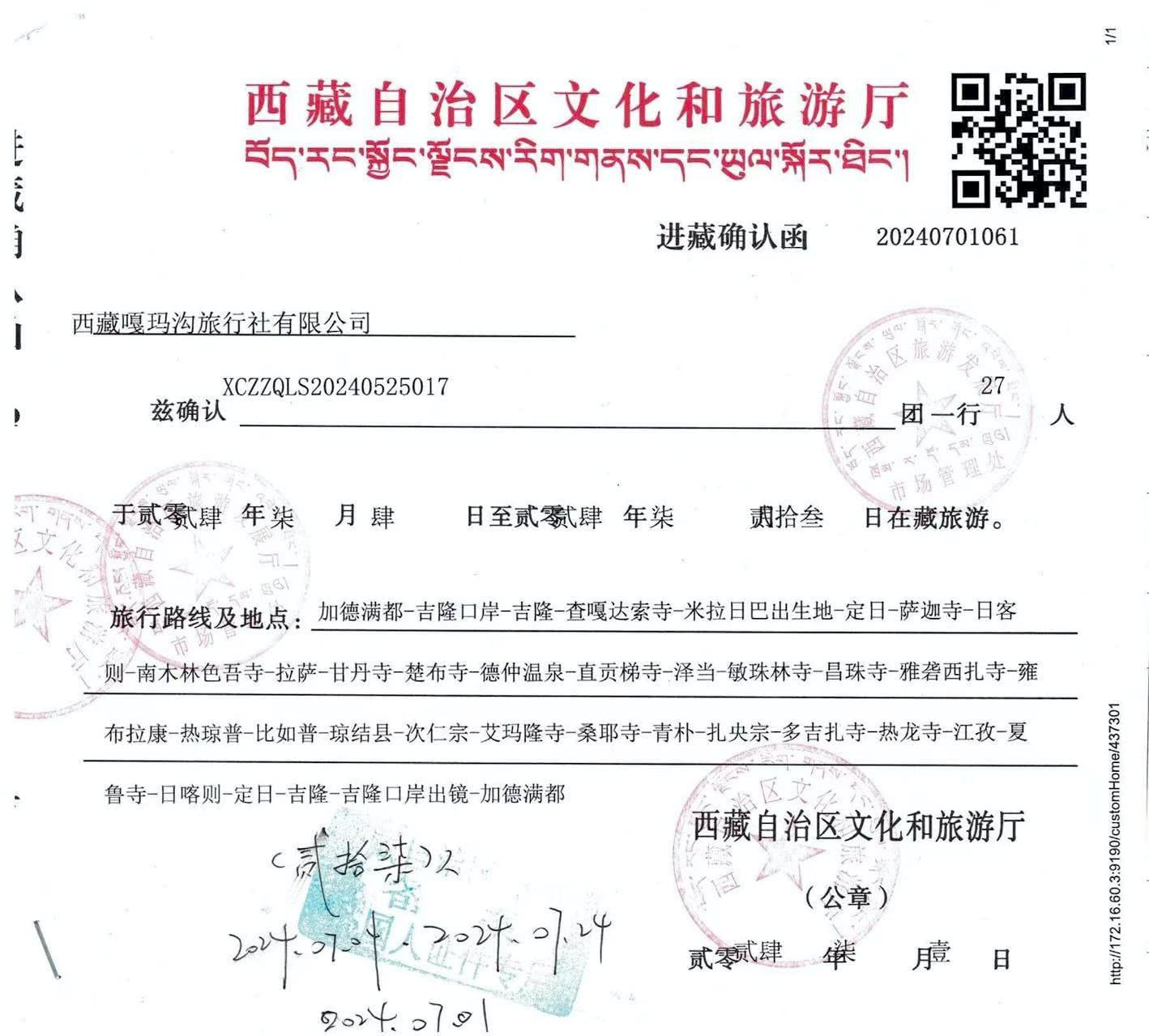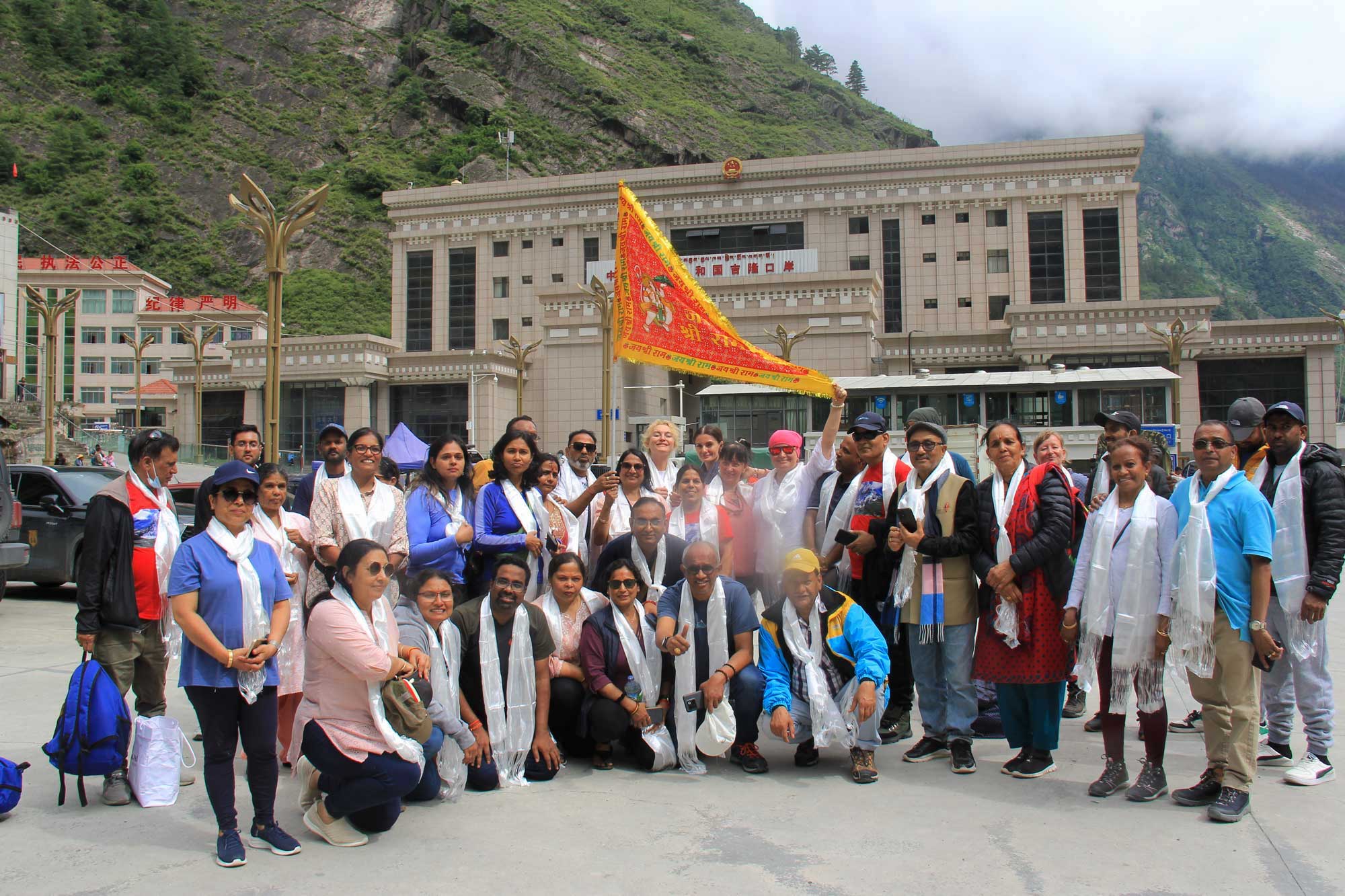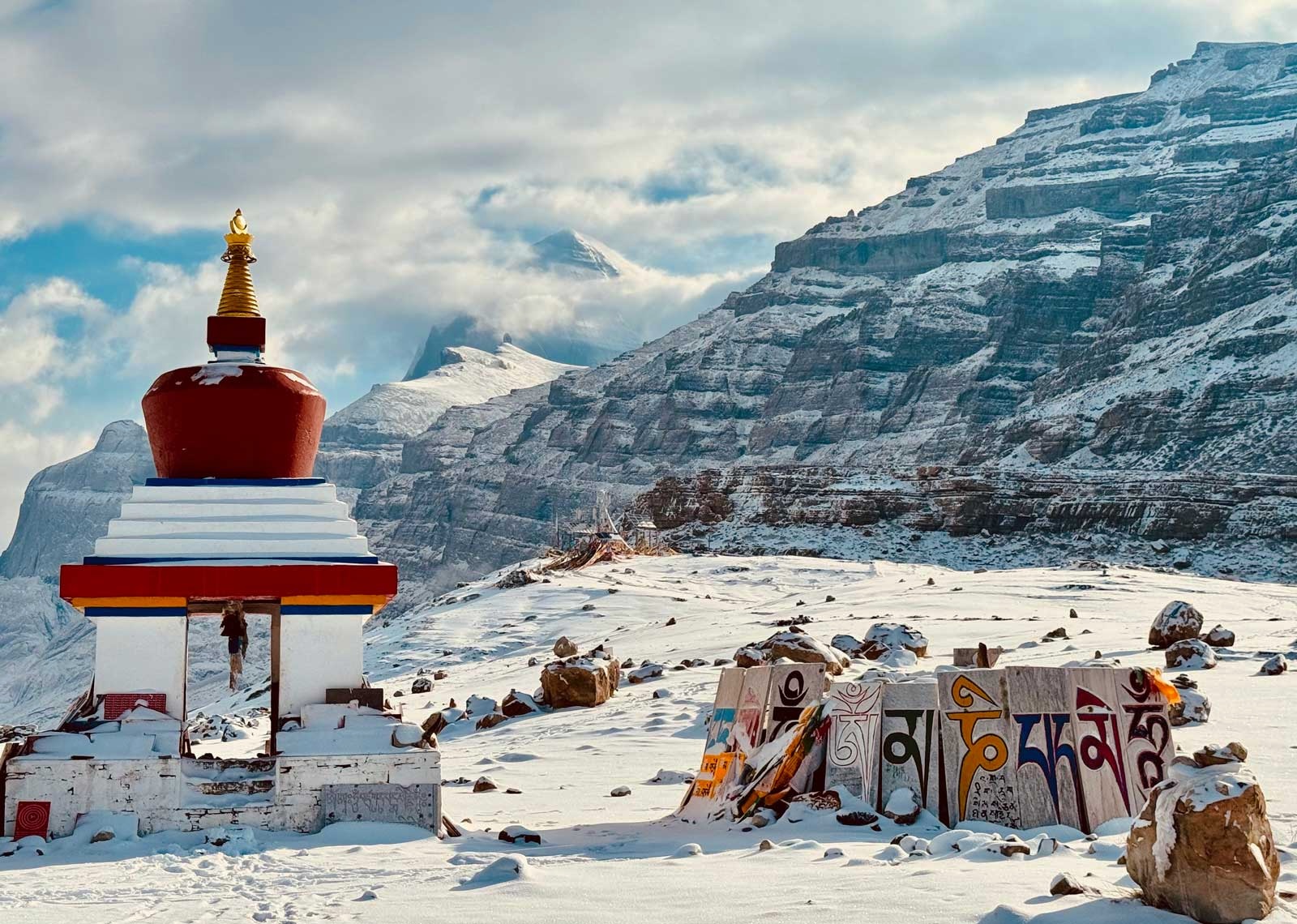Planning to visit Tibet? You’ll need a Tibet travel permit. This guide explains how to get one and what you need to know for a smooth experience.
Foreign passport holders must secure the Tibet Entry Permit through a licensed travel agency to enter Tibet and explore its regions legally.
Additional permits, such as the Aliens’ Travel Permit and Military or Army Permit, are required for accessing specific areas outside Lhasa and other restricted locations in Tibet. For tourists planning to enter Tibet from Nepal, obtaining a China group visa is essential. This visa allows entry into both Tibet and mainland China and requires adherence to group travel stipulations and service fees.
Start the permit application process at least 20 days in advance, ensuring all required documents, including a valid passport and Chinese visa, are submitted promptly to avoid delays. The Chinese visa is crucial for obtaining the Tibet Permit, and a clear copy must be provided along with other necessary documents. Without a valid permit Tibet, you can not board Tibet train or flight and check information about Tibet permit without tour.

Foreign tourists must obtain the Tibet Travel Permit to visit Tibet. The permit helps manage tourism and safeguards Tibet’s unique culture and environment. Foreign passport holders, including expats in China, need Tibet permit to enter Tibet. This requirement preserves Tibet’s delicate ecosystem and cultural heritage.
The Tibet Permit is an official document. It includes the names, travel dates, and destinations of a tour group. It outlines your entire itinerary within Tibet, including places like Lhasa, Shigatse, Everest, and Mt. Kailash. This approach helps authorities manage tourism and ensures respect for local customs and natural reserves. The tibet permit is essential for your journey.
Only foreign passport holders need to apply for the Tibet Travel Permit. Visitors from Taiwan must also obtain this permit. This regulation does not apply to Chinese nationals, including residents of Hong Kong and Macau. Securing this permit and the necessary tibet permits is the first step towards a memorable and legally compliant trip to Tibet.
A Tibet Permit is essential for all international tourists planning to travel to Tibet. This includes non-Chinese passport holders, overseas Chinese tourists without a Chinese passport, expats residing in mainland China, and Taiwanese citizens. Diplomats and journalists have a unique requirement; they must apply for the Tibet Permit exclusively through the China Foreign Affairs Office.
However, there is an exception for Hong Kong and Macau citizens. If they possess a Home Visit Permit, also known as a Mainland Travel Permit, they can visit Tibet without needing a Tibet Travel Permit. This regulation ensures that all international tourists comply with the necessary legal requirements to protect Tibet’s cultural and environmental integrity.
Understanding the types of permits required is crucial when planning a trip to Tibet. Additional permits may be required depending on the regions you plan to visit. For areas outside of Lhasa, such as Mount Everest Base Camp and Samye Monastery, the Alien’s Travel Permit, Foreign affairs permit, or residence permit is necessary. This permit is issued by the Public Security Bureau and is distinct from the Tibet visit Permit. Travelers must apply for it upon arrival in Lhasa, often with assistance from local travel agencies. Submission of your original passport, China visa, and Tibet Entry Permit is required.
The Military Permit is required for visiting restricted regions like Mount Kailash and other sensitive areas. It ensures respect for the security and sovereignty of these regions. These permits are essential for travelers exploring beyond usual tourist routes.
Travelers must work with a licensed travel agency in Tibet to apply for these permits. These agencies handle the application and ensure all necessary documents are submitted. Collaboration with local agencies streamlines the permit process and eases navigation of bureaucratic requirements. It always hustle-free to obtain Tibet travel permit by booking your Tibet tour with us to the Tibet autonomous region.
The application for a Tibet Travel Permit begins with booking a tour through a local tour agency. Independent travel in Tibet is not allowed, so a tour must be arranged with a licensed agency. The agency handles the permit application on your behalf, simplifying the process and including Tibet permit cost in the tour price.
Foreign tourists must have a valid China visa before applying for the Tibet Travel Permit. The process typically involves submitting copies of your passport, china tourist visa, and occupation details. Start this process at least 20 days before your Tibet tour date for timely processing.
After booking your tour and submitting documents, the travel agency’s application process is managed by the agency. The agency confirms the permit’s readiness before your travel date to ensure everything is in order. Close cooperation with your travel agency and providing accurate information helps avoid rejections or delays.
Booking a tour with a local travel agency is mandatory for obtaining the Tibet Travel Permit. Since independent travel is not permitted in Tibet, choosing a reliable licensed agency is crucial. Choose agencies with a proven track record and experience in handling tours. They are authorized by the Tibet Tourism Bureau to apply for permits on behalf of tourists.
You can choose group or private tours according to your preferences when booking. Tour packages often include permit costs, simplifying the process for travelers.
Book your tour 20-25 days in advance to ensure all necessary permits are arranged on time. Your travel agency will handle the entire permit application process once your tour is confirmed.
After booking your Tibet tour, obtain and submit your Chinese visa. Apply for the l visa application at your local Chinese Embassy or Consulate based on your state of residence. Ensure you have all necessary documents including tour itinerary and Tibet tour plan, including a completed China visa application form and a valid passport.
Send a clear scanned copy of your Chinese visa to your travel agency once you receive it. This document is essential for your agency to apply for your Tibet Travel Permit. Submit your visa application well in advance to avoid delays affecting your travel plans.
To complete your Tibet Travel Permit application, send copies of your passport and China visa to your travel agency. If you hold a work or student visa, provide a letter from your employer or educational institution. Send these documents via email.
Ensure your passport has at least six months of validity when applying for the Tibet Travel Permit. Accurately and promptly providing all required documents will expedite the application process and increase approval chances.

Special procedures apply if you plan to enter Tibet from Kathmandu. A key requirement is obtaining a China Group Visa (Tibet visa), mandatory for all foreign travelers from Kathmandu. This Tibet visa or Chinese visa serves a dual purpose, allowing entry into both Tibet and mainland China, and is valid for up to 30 days. Note: Even if you are Chinese visa holders, you will a new Tibet group visa from Chinese Embassy with paying visa fee. Indian travel agencies and clients with Nepal visa holders also need to go through the same step.
Travelers must book a Tibet tour group with a registered operator in Nepal and Tibet to apply for the Chinese Group Visa. Tibet company is responsible to send a visa invitation letter through Tibet tourism bureau for the Chinese group visa of 4 people. The tour operator’s representative must submit the application in person at the Chinese Embassy in Kathmandu. Arrive in Kathmandu at least three working days before departure to allow enough time for the visa process.
Have your China Group Visa ready when flying from Kathmandu to Lhasa or overland via Kyirong border. Present it along with your passport at the check-in counter in Tribhuvan International Airport or the border custom.

The cost of the Tibet Travel Permit is usually included in the Tibet tour package, so there is no additional fee. This simplifies booking since travelers don’t need to worry about separate thepermit costs.
Some agencies, like Adventures In Tibet Travel Agency, offer the permit free of charge with their tour packages. Be aware that additional costs may apply for expedited processing during peak travel times.
Additional permits are necessary for visiting restricted areas in Tibet. The Alien’s Travel Permit is required for regions outside Lhasa, such as Shigatse, Shannan, and Ngari. This permit is essential for tourists intending to visit ‘unopened’ areas like Mount Everest and Samye Monastery. Issued by the Public Security Bureau, it is distinct from the Tibet Travel Permit and must be applied for upon arrival in Lhasa, often with assistance from local tour agencies.
Tibet Military Permit and the residence permit is needed for access to non-open regions like Bomi, Ngari (including Mount Kailash and Lake Manasarovar), and military-sensitive areas. These permits ensure travelers respect the security and regulations of these sensitive regions.
Climbing permits are required for Mount Everest above the Base Camp. Please note that Amdo and Kham Tibetan areas do not require Tibet permit to vist.

Foreign travelers must display their Tibet Entry Permit when traveling to Tibet by train. A copy of the Tibet permit is usually sufficient for regular train to Lhasa routes, but the original is required for specific routes from cities like Xian, Lanzhou, and Chongqing. The Tibet permit will be checked at railway stations prior to boarding along with your Chinese visa.
For flying to Tibet, present a valid passport and the original Tibet Entry Permit at check-in. Carry multiple copies of the permit Tibet for use during different stages of your journey. The Tibet Travel Permit specifies tourists’ itineraries, ensuring a well-organized travel experience.

As of March 15, 2024, travel to Tibet for overseas tourists and foreign expats will open, with trips expected to start in the first week of April 2024. No new rules are anticipated for the Tibet Permit in 2025. Thus, the existing regulations will likely remain. Please check China visa-free policy around 53 countries released until 30th December 2025.
Additional costs may apply for expedited processing during peak travel times.
Plan well in advance to ensure a smooth application process for your Tibet Travel Permit. Start the application process at least 20 days before your travel date to avoid delays or cancellations. Double-check that you have included all required documents to avoid common mistakes in your permit application.
When applying for a Tibet Travel Permit, avoiding common mistakes can save you from delays or even trip cancellations. Here are some pitfalls to watch out for:
Not Booking a Tour with a Registered Local Tibet Travel Agency: Independent travel is not allowed in Tibet. Ensure you book your tour with a licensed local Tibet tour company based in Lhasa.
Not Providing Required Documents: Make sure your passport has more than six months of validity and that you have a valid Chinese tourist visa.
Not Applying in Advance: Start the application process at least 20 days before your travel date to allow enough time for processing and delivery.
Not Checking Permit Validity: Verify the validity of your Tibet Travel Permit before entering Tibet to avoid any last-minute issues.
Not Carrying the Original Permit: Always carry the original Tibet Travel Permit when entering Tibet, as it will be checked at various points during your journey.
By steering clear of these common mistakes and travel tips, you can ensure a smoother and more enjoyable trip to Tibet.
Only registered travel agencies can assist foreigners in obtaining the Tibet Travel Permit. Tibet Holiday International Travel, a prominent agency, has headquarters in Lhasa and branches in Kathmandu and China, providing comprehensive travel solutions. It is important to know that Tibet permit without tour is totally impossible.
Contact Tibet Holiday via phone or email for assistance with booking changes and permit inquiries. Tibet Holiday caters to over 8000 tourists annually and is the largest local tour operator in Tibet.
Selecting a reliable local Tibetan agency is crucial for obtaining your Tibet Travel Permit. Here are some key factors to consider:
Registration: Ensure the agency is registered with the Tibet Tourism Bureau and holds a valid license to operate. This guarantees they are authorized to handle Tibet Travel Permits.
Experience: Look for agencies with extensive experience in organizing Tibet tours and successfully obtaining permits. Experienced agencies are more likely to navigate the application process efficiently.
Reputation: Check online reviews and ask for referrals from previous clients. A good reputation indicates reliable service and successful permit applications.
Communication: Choose an agency with excellent communication skills. They should provide clear instructions and regular updates on the status of your permit application.
By choosing a reputable and experienced local Tibetan agency, you can streamline the permit application process and focus on enjoying your Tibet tour.
Securing your Tibet permit is a detailed process that requires careful planning and coordination with a licensed tour agency. By understanding the different types of permits, submitting the necessary documents, and following the special procedures for entering Tibet from Nepal, you can ensure a smooth and memorable journey to this mystical land.
By adhering to the guidelines and tips provided in this blog post, you will be well-prepared to navigate the permit application process and embark on your adventure to the roof of the world. Whether you’re visit Lhasa or trekking to Everest Base Camp, having the right permits will make your journey seamless and legally compliant.
It’s essential to check with your local Tibetan travel agency and the Tibet Tourism Bureau for the specific requirements and regulations applicable to your nationality. This ensures you meet all the necessary criteria for a smooth and compliant entry into Tibet.